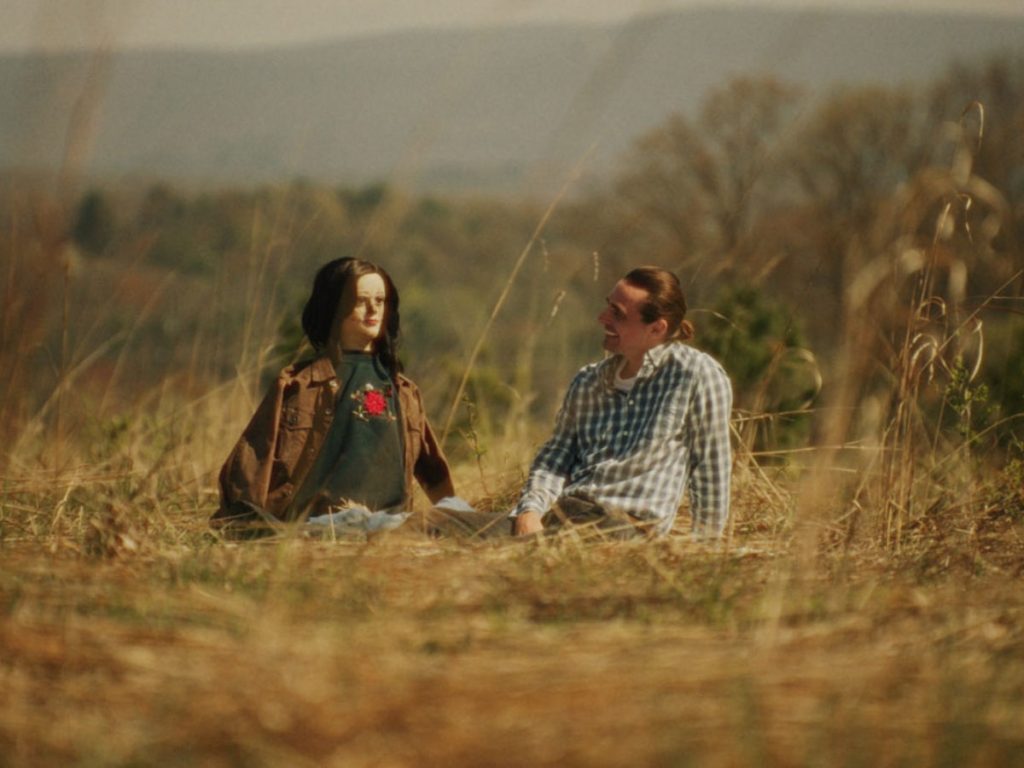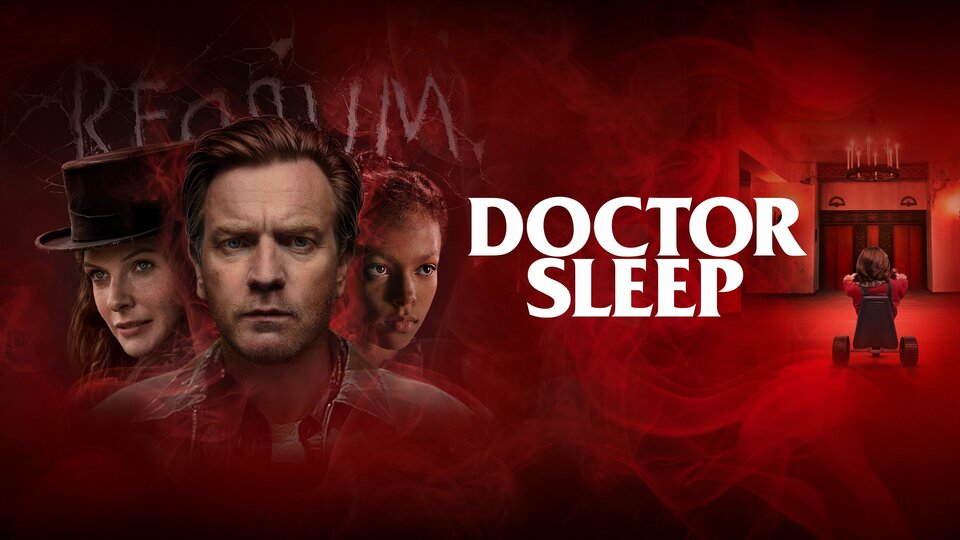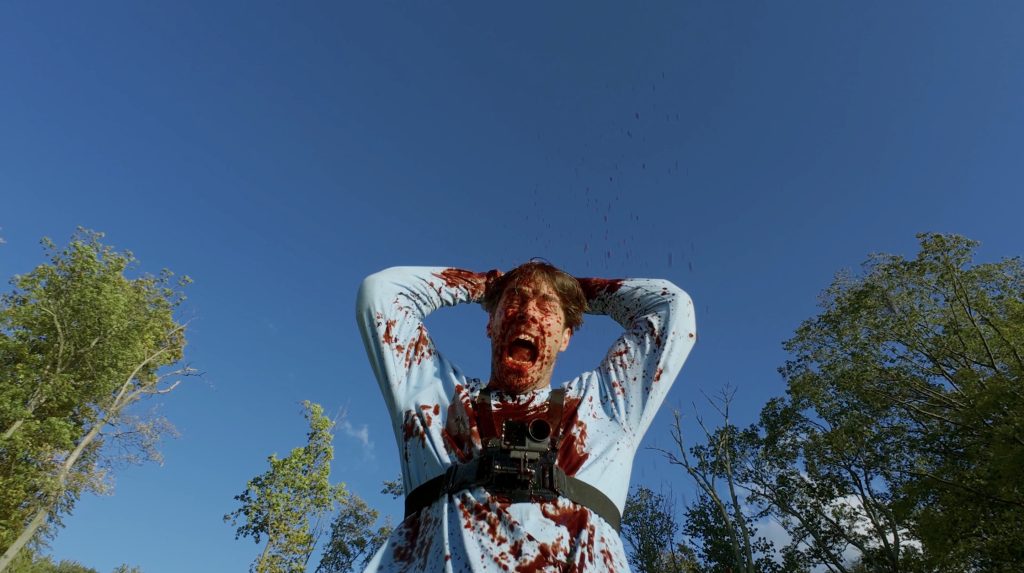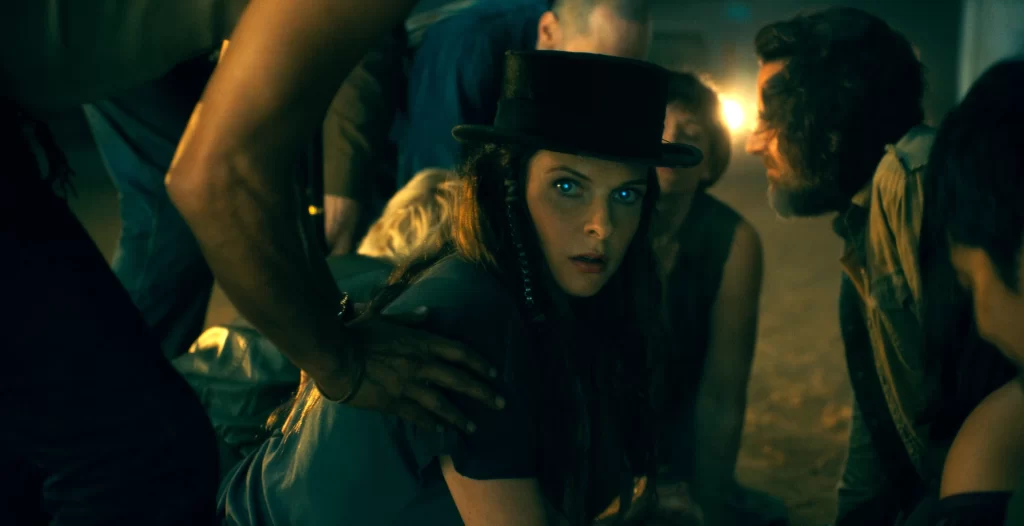Reviews
Brooklyn Horror Film Festival 2025: Home Invasion 1 Shorts Block

Short films are the cornerstone of any good film festival. Sometimes shorts are packed before and after an accompanying feature, sometimes they get their own blocks. Whatever the case is, I’ll show up. Rarely does a film festival program its shorts to be nearly as great as the feature films; Brooklyn Horror Film Festival does.
The Binding // Written and directed by Ryan Kennedy
Stephen (Mike Houston) is a grieving father. Parker (Mel House) is (basically) a demon bounty hunter for hire. Can these righteous individuals beat the ticking clock and bind the demon to a human conduit?
This was the very first film I had the opportunity to see at Brooklyn Horror Film Festival. To say this set the bar for my entire festival experience would be an understatement. Religious horror/possession horror rarely ever works for me. I find these types of stories often overjustify unbelievable story beats because, well, demon. (Said like Giorgio Tsoukalos.) The Binding was quite the surprise.
Writer/director Ryan Kennedy takes an overdone subgenre and makes it feel new and exciting. Sure, stories like this have been told in broader ways, but Kennedy’s telling of this tale adds a humanistic layer to it. Gone are the Warren and Bagans-like characters who know the answers. Kennedy’s idea to make the main characters a grieving father and a demon bounty hunter ups the stakes while grounding the overall story.
Y.M.G. // Written and directed by Alexandra Warrick
A boyfriend (Joe Gallagher) breaks the fourth wall to tell the audience all of the things he loves about his girlfriend. From there, I don’t really know how to explain what happens except that the (potentially dead) girlfriend (Meg Spectre) gives a haunting musical performance.
Throughout the first few minutes of Y.M.G., I couldn’t figure out what the angle was. Why was this guy telling us all of these “my girlfriend” statements? How is this horror? And then we arrived at his apartment. One of the best things about short films is that there is no structure they need to stick to, no real rules to abide by. If you want to put a full three (and a half?) minute-long musical break into it…you can!
Alexandra Warrick’s blood-soaked epic takes an experimental turn in a way I don’t think I’ve seen before. Something about it feels like it shouldn’t work as well as it does, but I can’t help how many times I’ve thought about this film since I’ve seen it. The unattributed quote of “When words aren’t enough, you sing,” (no, it wasn’t Stephen Sondheim) couldn’t be more accurate than with Y.M.G..
The more I sat on the underlying idea of Y.M.G., the more it became apparent. How many times have you seen a true crime documentary or TV news interview where people say, “He was so nice, I never would have suspected him of this”? The boyfriend IS supposed to come off as a nice, wholesome guy when, in reality, a sinister being lurks behind the thousand-dollar smile. It’s to highlight the fact that no matter what you think, there’s a good chance you may not know what you think you know about your partner. Y.M.G. is a chilling film that provides an incredibly deep story with beautifully haunting visuals.
Brian Won’t Wear Condoms // Written and directed by Genna Edwards
(Please note, I wasn’t able to find many names regarding the cast/crew.)
Abby is a wellness influencer whose boyfriend, Brian, refuses to wear condoms. His refusal leads to Abby trying out a new form of contraception. Abby’s best friend doesn’t quite know how to feel about it, but wants to be there for Abby. What follows is a grotesquerie of epic proportions. (Yes, I’m talking about that scene.)
After reading an interview between Odd Critic and filmmaker Genna Edwards, one thing became clear: we have the same sex-ed experience. I’m from a town in Pennsylvania where you had to travel about one mile into the forest for high school. That should explain enough.
My middle school sex-ed teacher was a macho, dark black bottle-dyed, ex-military man who regularly arrived at school with dried deer blood in the back of his pickup truck. I come from a red-leaning purple town, but sex-ed was definitely not at the front of my school board’s mind. All of that is to say, I empathize with why and how Genna feels about how many (most?) men view their pleasure in sex.
Brian Won’t Wear Condoms exemplifies the struggle (I think) many people face in heterosexual relationships. Because Brian refuses to do the bare minimum, Abby takes charge in her own way. Unfortunately for Abby, that doesn’t come without consequences. I’ve heard people say things along the lines of their birth control (mainly IUDs, but also the pill) making them suicidal. If you truly loved your partner, wouldn’t you want to do the easiest step you could take to make them a bit more comfortable?
One of my favorite things about this short is how there are two ways to view it. If you’re a normal, good person, then you can see Abby’s struggle and sympathize with the physical and mental pain she’s put through. And if you’re a Brian, Genna introduces one of the most grotesque shots in horror cinema to make you SEE and FEEL Abby’s pain. Let’s just say, it’s one of the most impactful theatrical experiences I’ve had in a long time.
The Man & The Scarecrow // Written and directed by Justin Knoepfel

A man (Jacob A. Ware) struggles as he and his ex-wife (Kelly Grago) navigate a divorce. One day, while on the road, the man sees something that only he and Pearl would stop for…a scarecrow. And, like Pearl, the man forms a connection with the scarecrow.
Everyone copes differently, and Justin Knoepfel humorously navigates that topic. While Knoepfel plays into the humor of the whole situation, there’s a distinct amount of melancholy behind the whole idea. Most people have gone through a difficult breakup of sorts, and we all handle it differently. The man in this film just takes his grief a bit further than usual.
Knoepfel’s film is fairly down the middle, balancing normalcy and absurdism. On the surface, projecting your emotions onto an inanimate scarecrow is odd. And that’s really the furthest the film takes the idea. I wished it had delved a bit more into the man’s psyche to explore a wider range of emotions. But, at the end of the day, it was an enjoyable watch.
Some Dark Matter // Written and directed by Molly Fisher
A family dinner comes to a quick end after a husband/father dies of a stroke. Most are sad, except one. One daughter remains void of visible emotion. It’s not until a night alone in a hotel that she finally has to express her emotions…unless they express themselves first.
Some Dark Matter was a complete 180, lineup-wise, from the previous film. The Man & The Scarecrow had a levity to it, while Some Dark Matter is pure grief. It’s a very on-the-nose film that doesn’t have quite the bite I would hope for. Molly Fisher does a great job of slowly building the unnerving atmosphere that makes this film work as a horror property, which is obviously the most important aspect. But to me, it provides surface-level commentary on grief and loss, rather than delving deeper into the overall process.
You Have Her Eyes // Written by Lizzy Miller, Jordan Sommerlad, and Cory Stonebrook, and directed by Jordan Sommerlad and Cory Stonebrook
Elle (Lizzy Miller) and Jacob (Cory Stonebrook) are happy enough. They seem to have a wonderful relationship, a gorgeous house, and a wonderful group of friends. What more could you want?! Well, for Jacob, how about a baby? Elle is on the fence until an old, familiar face rears their head.
Oh boy, this one got me. You Have Her Eyes is a damn effective piece of psychological horror that gets right under your skin. It’s rare for a short film to pull the rug out from under you. The twist in this story by Miller, Sommerlad, and Stonebrook is a gigantic punch to the gut. And if anyone tells you they saw it coming, I can bet you a decent chunk of money that they’re lying.
Eyes takes a somber look at familial values, the human condition, and unconditional love. Elle’s slow descent into terror is done uniquely and brilliantly; it’s nearly impossible not to be chilled to your core with this film. When I tell you that the entire theater gasped at that moment, it’s no exaggeration. A film like this is a perfect example of effective storytelling in a short time.
Rebrand // Written and directed by Edoardo Ranaboldo
Leo (Adam Alpert), Alex (Xavier Clyde), Jess (Eleanor Lougee-Heimer), and Trey (Charlie McElveen) are a group of camping YouTubers. While they’ve seen great success with their channel, they’re ready to spread their wings and take on other personal tasks. But the crusade of campers isn’t alone on their final foray into the forest. A group of masked men, armed with cameras of their own, is hot on their trail.
Rebrand was clearly a crowd favorite. And, interestingly, it was the only found footage film in this entire block. Found footage is an easy go-to for short films, especially those that forgo proper permits. But Edoardo Ranaboldo didn’t pick found footage for ease or permit evasion.
Aside from Un Chien Andalou and The Big Shave, rarely does a short film define a moment in filmmaking. Rebrand has the ability not only to change found footage fundamentally but also to bring life back into a tired subgenre. Ranaboldo did everything right. His story has intrigue, stakes, emotion, [some] humor, and a HELL of a lot of blood. Moreover, the cameras and character motivations make sense, and the story is just incredibly compelling.
Rebrand is everything a short film should be. If you can’t tell, it was clearly my favorite. While it doesn’t do much on the commentary side of the conversation, that’s okay. Ranaboldo doesn’t outwardly try to make the film more than it is, and that’s okay! That’s not to say it’s a substance-less film. But, at the end of the day, Rebrand absolutely kills. And it kills incredibly well.
Reviews
‘Doctor Sleep’ Is Mike Flanagan’s Finest Hour

If there was ever any horror film that managed to surpass what came before it, let it be known that few have been as successful at it as Mike Flanagan’s Doctor Sleep.
Sacrilege, some might say, to throw Kubrick out into the snow and raise a sequel to such high esteem. But the fact of the matter is, with Doctor Sleep now six years in the rear view, it’s still shining as bright as it can. It’s a marvel, on both a technical and narrative level, and stands tall as the best of all the Stephen King adaptations and as Mike Flanagan’s finest hour.
After his father Jack was taken from him by the Overlook Hotel in 1980, Dan Torrance is a changed man. Struggling against alcoholism and his latent “shine”, a psychic ability that forces him to see the spirits of the dead, Dan tries his best to shut out the horrors of his past and the world beyond most people’s sight. Even when he gets sober, he hides away at a quiet job as a hospice orderly and spends most of his time in a rented room. But when a gifted young girl named Abra is terrorized by a mysterious and cruel cult that feeds on those that shine, Dan is forced to wrestle personal demons within and monsters without to protect her.
Doctor Sleep is The Kind of Director’s Cut You Need
Despite how close the two stories are, Kubrick’s The Shining and Flanagan’s Doctor Sleep, are so different and yet so perfectly intertwined. The story of Dan, Abra, and the True Knot, is one that really earns every minute of its runtime as it sculpts more life into the world of The Shining. It’s for that reason that between the theatrical cut of the film and the director’s cut, I have to go for the director’s cut every time. The dialogue benefits from the relaxed pace the extra 30 minutes buys it, allowing for little moments of character development absent from the original.
The director’s cut also has some vital bits of dialogue that, for the life of me, I can’t explain the absence of in the original cut; most of these not only develop Dan’s healing process throughout the film but also elaborate on the events and aftermath of The Shining in a whole new way. And even at a hefty three hours, the film is paced so well that the difference between the two cuts is hardly even noticeable. That half hour doesn’t just breeze by, it pulls you in and keeps you locked in.
A Technical Showstopper in Its Own Right
Though its plot and look owe quite a lot to The Shining, what Mike Flanagan has done with the film’s very particular cinematography is formidable in its own right. Sleep is best known now for resurrecting elements of Kubrick’s aesthetic spot on, recreating costumes, sets, and lighting to be more in line with the first film (this includes a dead-on recreation of, spoilers, the Overlook Hotel). And that is thoroughly impressive, especially with the casting of our Wendy and Jack this time around. But in the buildup to that recreation, Doctor Sleep forms a mirror to the aesthetics Kubrick played in, bridging the visuals of both movies.
It takes the cold, detached, isolating camerawork and framing of Kubrick’s film and brings them out into the real world, no longer confined to the Overlook. It examines what that isolation feels like when, though you have people in your life and those you call friends and family, you can’t get away from your own loneliness or desire to escape. When the confines are no longer physical, but mental, how can you still feel so trapped? The film plays with this notion of freedom within the mind multiple times, most notably the psychic confrontation set pieces throughout.
Though its more grotesque aspects can be blood curdling, especially when it comes to scenes of the True Knot feeding, the movie is just as powerful when it generates that pure, all-consuming eeriness that permeates throughout. That eeriness is the eeriness of being disconnected from humanity, either emotionally or literally, in the case of our villains.
Ferguson and McGregor Make Horror History in Doctor Sleep
And through this environment and eerie air comes a cast of star players, headed by Ewan McGregor and Rebecca Ferguson. And frankly, it’s nearly impossible to pin down which performance is best between the leads here.
Ferguson’s career-defining time as Rose the Hat is the genesis of one of the most sinister horror villains of the past decade, showing out with this predatory gleam in her eye and a lilt in her voice that suggests something is ever so slightly off. Her vocal control is incredible, especially when her mask drops and she’s able to stop selling people on a false image and really bare her teeth.
Likewise, Ewan McGregor is truly captivating as Dan, whose struggles, both emotional and physical in the film, end up being one of the most gripping performances of his career. There’s tension in his muscles as he fights against every instinct to shut himself away and self-medicate, to run away from the problem. His decision to stay and fight leads to an insane climax, which crescendos the arc of Dan into something purely perfect.
King’s Tale of Pure Pathos, Fulfilled by Flanagan’s Execution
Doctor Sleep could never have been your bogstandard sequel, because the source material demanded excellence. It demanded a re-examining of a monster who was a man before all else, and of his broken child who grew into a shattered man like Dan Torrance. It demanded we see the capacity of that man to put himself back together. It demanded villains with rich interior worlds and a dark side that feels all too real.
And above all else, it demanded a captivating ending that pierces the heart, and pays respect to both the source material and the legendary film that transcended it. And on all demands, Mike Flanagan delivered.
Reviews
‘Frankenstein’ Review: Guillermo Del Toro Is Off to the Races

Those expecting Guillermo Del Toro’s Frankenstein to be similar to the book, or to any other adaptation, are in for something else. A longtime enjoyer of the creature’s story, Del Toro instead draws from many places: the novel, James Whale’s culturally defining 1931 film, the Kenneth Branagh version, there are even hints from Terence Fisher’s Curse of Frankenstein, and if the set design and costuming are to be believed, there are trace elements of the National Theatre production too.
The formulation to breathe life into this amalgam is a sort of storm cloud of cultural memory and personal desire for Del Toro. This is about crafting his Frankenstein: the one he wanted to see since he was young, the vision he wanted to stitch together. What results is an experience that is more colorful and kinetic and well-loved by its creator than any Frankenstein we’ve had yet, but what it leaves behind is much of its gothic heart. Quiet darkness, looming dread, poetry, and romance are set aside as what has been sold as “the definitive retelling” goes off to the races. It’s a fast-paced ride through a world of mad science, and you’re on it.
Victor Frankenstein’s Ambition and Tragedy
A tale as old as time, with some changes: the morbid talents and untamed hubris of Victor Frankenstein (Oscar Isaac) guide him to challenge death itself. Spurred by a wealthy investor named Henrich Harlander, and a desire for Harlander’s niece Elizabeth (Mia Goth), Victor uses dead flesh and voltaic vigor to bring a creature to life. His attempts to rear it, however, go horribly wrong, setting the two on a bloody collision course as the definitions of man and monster become blurred.
Guillermo Del Toro’s Frankenstein is more Hellboy in its presentation than it is Crimson Peak; it’s honestly more similar to Coppola’s Dracula than either of them. The film is barely done with its opening when it starts with a loud sequence of the monster attacking Walton’s ship on the ice. Flinging crew members about and walking against volleys of gunfire, he is a monstrosity by no other name. The Creature (Jacob Elordi) cries out in guttural screams, part animal and part man, as it calls for its creator to be returned to him. While visually impressive (and it remains visually impressive throughout, believe me), this appropriately bombastic hook foreshadows a problem with tone and tempo.
A Monster That Moves Too Fast
The pace overall is far too fast for its first half, even with its heavy two-and-a-half-hour runtime. It’s also a far cry from the brooding nature the story usually takes. A scene where Victor demonstrates rudimentary reanimation to his peers and a council of judges is rapid, where it should be agonizingly slow. There’s horror and an instability in Victor to be emphasized in that moment, but the grotesque sight is an oddly triumphant one instead. Most do not revile his experiments; in fact he’s taken quite seriously.
Many scenes like this create a tonal problem that makes Victor’s tale lean more toward melodrama than toward philosophical or emotional aspects; he is blatantly wild and free, in a way that is respected rather than pitied. There are opportunities to stop, breathe in the Victorian roses and the smell of death, to get really dour, but it’s neglected until the film’s second half.
Isaac’s and Goth’s performances are overwrought at points, feeling more like pantomimes of Byronic characters. I’m not entirely convinced it has more to do with them than with the script they’re given. Like Victor working with the parts of inmates and dead soldiers, even the best of actors with the best of on-screen chemistry are forced to make do. The dialogue has incredibly high highs (especially in its final moments), but when it has lows, how low they are; a character outright stating that “Victor is the real monster” adage to his face was an ocean floor piece of writing if there ever was one.
Isaac, Goth, and Elordi Bring Life to the Dead
Jacob Elordi’s work here, however, is blameless. Though Elordi’s physical performance as the creature will surely win praise, his time speaking is the true highlight. It’s almost certainly a definitive portrayal of the character; his voice for Victor’s creation is haunted with scorn and solitude, the same way his flesh is haunted by the marks of his creator’s handiwork. It agonizes me to see so little of the books’ most iconic lines used wholesale here, because they would be absolutely perfect coming from Elordi. Still, he has incredible chemistry with both Isaac and Goth, and for as brief as their time together is, he radiates pure force.
Frankenstein Is a Masterclass in Mise-En-Scène
Despite its pacing and tone issues, one can’t help but appreciate the truly masterful craftsmanship Del Toro has managed to pack into the screen. Every millimeter of the sets is carved to specification, filled with personality through to the shadows. Every piece of brick, hint of frost, stain of blood, and curve of the vine is painstakingly and surgically placed to create one of the most wonderful and spellbinding sets you’ve seen—and then it keeps presenting you with new environments like that, over, and over.
At the very least, Del Toro’s Frankenstein is a masterpiece of mise-en-scène down to the minutest of details, and that makes it endlessly rewatchable for aesthetic purposes. This isn’t even getting into the effervescent lighting, or how returning collaborator Kate Hawley has outdone herself again with the costuming. Guillermo Del Toro tackling the king of gothic horror stories, a story written by the mother of all science fiction, inevitably set a high bar for him to clear. And while it’s not a pitch perfect rendering of Mary Shelley’s slow moving and Shakespearean epistolary, it is still one of the best-looking movies you will see all year.
Perhaps for us, it’s at the cost of adapting the straightforward, dark story we know into something more operatic. It sings the tale like a soprano rather than reciting it like humble prose, and it doesn’t always sing well. But for Del Toro, the epic scale and voice of this adaptation is the wage expected for making the movie he’s always dreamed of. Even with its problems, it’s well worth it to see a visionary director at work on a story they love.

























